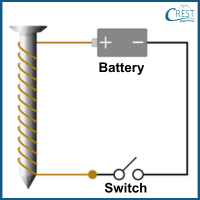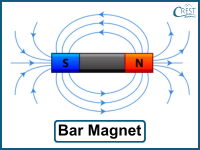1. Look at the setup of an electromagnet given below. What would we observe if some iron fillings are brought near it?

a) The iron filings will be strongly attracted to the electromagnet.
b) The iron filings will repel the electromagnet.
c) The iron filings will remain unaffected by the electromagnet.
d) The iron filings will generate their own magnetic field.
Answer: c) The switch in the circuit is off so there will be no flow of electric current through the coil, and the electromagnet will not generate a magnetic field. In this case, if iron filings are brought near the electromagnet, they will not be attracted or influenced by any magnetic force. They will simply remain unaffected by the electromagnet.
2. A student wants to magnetise a glass rod. Which of the following methods should she use?
a) Single-touch method
b) Double-touch method
c) Using electricity
d) Glass cannot be magnetised
Answer: d) Glass is a non-magnetic material and cannot be magnetised using conventional methods. It does not have the necessary properties to become magnetised like materials such as iron or steel.
3. In the following question, you will find an assertion and a reason. Select the appropriate option that applies.
Assertion: Temporary magnets lose their magnetism easily.
Reason:Temporary magnets are usually made from materials with high magnetic retention. When the external magnetic field is removed, their magnetism loses quickly.
a) Both assertion and reason are true and reason is the correct explanation of assertion.
b) Both assertion and reason are true and reason is not the correct explanation of assertion.
c) Assertion is true but reason is false.
d) Assertion is false but the reason is true.
Answer: c) Assertion is true but reason is false.
The assertion is correct as it states that temporary magnets lose their magnetism easily. However, the reason provided is incorrect. Temporary magnets are actually made from materials with low magnetic retention, such as soft iron.
4. Consider the following statements and choose the correct option:
Statement I: The Earth's magnetic field is strongest at the equator and weakest at the poles.
Statement II: The Earth's magnetic field is responsible for aligning compass needles along the North-South direction.
a) Statement I is correct but statement II is incorrect.
b) Statement I is incorrect but statement II is correct.
c) Both statements are correct.
d) Both statements are incorrect.
Answer: b) Statement I is incorrect but statement II is correct. The Earth's magnetic field is actually strongest at the poles and weakest at the equator. Additionally, the Earth's magnetic field is responsible for aligning compass needles along the North-South direction, which makes statement II correct.
5. Phoebe wants to store her magnets shown in the picture. How should they be stored to prevent them from becoming weak over time?

a) Separated and kept in a dry place
b) Stored in pairs with unlike poles on the same side
c) Stored in pairs with like poles on the same side
d) Wrapped in aluminium foil
Answer: b) Phoebe should store her magnets in pairs with unlike poles on the same side. This arrangement helps to prevent the magnets from becoming weak over time. By keeping the unlike poles together, it reduces the chance of their magnetic fields interfering with each other and maintains their strength.



